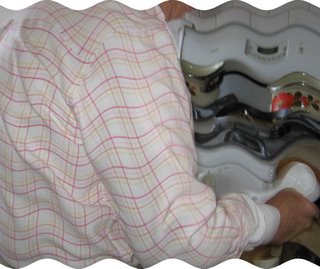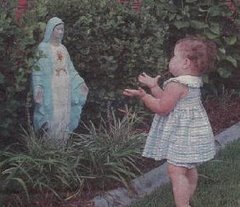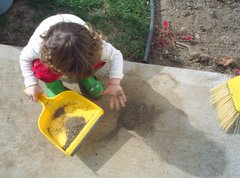Apr 21, 2007
Fantasy Vatican
The NCR was trying to be funny, but Wolftracker achieved real hilarity. See his Kansas City Catholic piece here.
Sedevecantism
A lot of traditional Catholics in Kansas City recently received a letter advertising "Counterfeit Catholicism," a talk to be given by Gerry Matatics. Gerry used to accept the Pope, but now has retreated to the belief that no Pope has occupied the chair of Peter since Pope Pius XII who died in 1958--almost 50 years ago. As is pointed out by one of the three indult priests serving traditional Catholics in the Kansas City area, this requires one to believe the Papacy is now extinct because no Cardinals appointed by the last 'valid' Pope, Pius XII, are alive to elect the next Pope. Sedevecantists cannot objectively describe when and by whom the next Apostolic Primate will be elected, indicating a Papal vacancy could last until the end of time.
Some other observations on and objections to sedevecantism (two Latin words which mean “the Chair is vacant”) include:
The terrible confusion in the Catholic churches today encourages poor understanding and judgment. Catholics find it difficult to explain how Popes can err in the governance of the Church, or approve 'new teachings' such as Limbo no longer exists. [Also see Fr. Brian Harrison's comments on Limbo.] Consequently, they turn their backs on the Church because the Captain can be an incompetent or unfaithful sailor.
My own opinion is that if St. Peter, the first Pope, could deny Christ three times, and even later had to be corrected by St. Paul for his error in compelling Gentiles to live as do the Jews (Gal. 2:11-15), then it isn't unusual to observe current Popes making mistakes--even very serious ones that lead to very critical damage in the Church. Yet the Church will continue to be led by a valid successor of St. Peter because Jesus promised Peter:
Some other observations on and objections to sedevecantism (two Latin words which mean “the Chair is vacant”) include:
- To a large extent, this theological position is a deeply emotional response to the horrors in the Church in the past 40 years, something we can all understand.
- Sedevecantism requires one to believe the visible and indefectible Church promised by Christ can exist without a successor to St. Peter for a very long time--generations--even though the longest time between the death of one Pope and the election of the next has been three years, with the Holy See providing a visible government in that short time period..
- Past Popes have been heretics and have continued at the helm of the Church. For example, Pope Honorius (625-638) was condemned in 680 by the 3rd Council of Constantinople because he favored the Monothelite heresy.
- Father Garrigou-Lagrange is one of several extremely well respected theologians who concluded in the past 500 years that a heretic Pope could still retain his jurisdiction if his heresies were not notorious and pertinacious. [And only a very few Catholics are acquainted with the charges that recent Popes were heretics.]
- Jesus Christ instituted a visible Church with a visible leader. The Church was designed by Christ never to be a rudderless ship without a Captain--a successor of St. Peter.
- Sedevecantism is reduced to the absurd (reductio ad absurdum) when one considers:
- An imposter Pope would always act invalidly, eliminating the rule of obedience
- All church laws and spiritual activities from Rome would be either evil or worthless
- This malignant cancer would completely destroy the Church, contrary to Christ's promise
- An imposter Pope would also be an false Bishop and could not legitimately consecrate other Bishops
- No cardinals to elect the next Pope could be validly appointed by an imposter Pope
The terrible confusion in the Catholic churches today encourages poor understanding and judgment. Catholics find it difficult to explain how Popes can err in the governance of the Church, or approve 'new teachings' such as Limbo no longer exists. [Also see Fr. Brian Harrison's comments on Limbo.] Consequently, they turn their backs on the Church because the Captain can be an incompetent or unfaithful sailor.
My own opinion is that if St. Peter, the first Pope, could deny Christ three times, and even later had to be corrected by St. Paul for his error in compelling Gentiles to live as do the Jews (Gal. 2:11-15), then it isn't unusual to observe current Popes making mistakes--even very serious ones that lead to very critical damage in the Church. Yet the Church will continue to be led by a valid successor of St. Peter because Jesus promised Peter:
And I say to thee: That thou art Peter; and upon this rock I will build my church, and the gates of hell shall not prevail against it. And I will give to thee the keys of the kingdom of heaven. And whatsoever thou shalt bind upon earth, it shall be bound also in heaven: and whatsoever thou shalt loose upon earth, it shall be loosed also in heaven. (Matt 16:18-19)The Church exists to bring men to holiness by the sacraments, the sacrifice of the Mass, and by transmitting the teachings of Jesus to future generations. It will not and cannot fail this mandate.
Apr 20, 2007
Our "Sunday Best"
 This post continues the discussion of dressing up for Sunday Mass. To clarify, we are not talking about wearing our "Sunday Best" clothes for weekday Mass. People work during the week and often can attend Mass only if they wear their work clothes.
This post continues the discussion of dressing up for Sunday Mass. To clarify, we are not talking about wearing our "Sunday Best" clothes for weekday Mass. People work during the week and often can attend Mass only if they wear their work clothes.Millet's painting of peasants praying the Angelus shows the work clothes of European farmers of almost 200 years ago. These clothes might have been worn for daily Mass (probably after they washed their hands and the woman took off her dirty apron), yet the peasants would have worn their "Sunday Best" on God's Day.
A lot of time was required to dress in their "Sunday Best." My Grandma said that to obtain lye, she would filter water poured
 through wood ashes. She said the lye water would bleach the white shirts worn by the men to Sunday Mass. Washing was often done by hand using a washboard. [Does anyone even have one of those? I do, but now seldom use it.] Shoes were polished for Sunday. Regardless of how poor they were, everyone was expected to be dressed up, clean, and neat for Mass.
through wood ashes. She said the lye water would bleach the white shirts worn by the men to Sunday Mass. Washing was often done by hand using a washboard. [Does anyone even have one of those? I do, but now seldom use it.] Shoes were polished for Sunday. Regardless of how poor they were, everyone was expected to be dressed up, clean, and neat for Mass.For over forty years, two of my aunts even dressed up in "church clothes" for early daily Mass (6:00 am), then changed into house and farm work clothes when they came home. It would have been unthinkable for both of them to wear their "everyday clothes" to church to greet God and receive the Eucharist.
The men who attended daily Mass were different because they had to wear their work clothes to church as most of them left Mass to go directly to work. Yet, work clothes were considered highly unsuitable to wear for Sunday Mass, unless the man had a job requiring him to leave Mass immediately to go to work on Sunday. Sunday jobs were not common (mostly firemen, a few policemen, and a small number of utility workers).
To give a feel for the effort to get ready for Sunday Mass, I remember my mother washing our shoe laces and restringing them, and polishing our white shoes on Saturday so that my siblings and I would look our best for Sunday Mass. We took weekly baths and washed our hair on Saturday, so that we would be our cleanest and smell nice for Sunday. Sunday was a much more special day then than it is now, and our appearance mattered because beauty, order, and cleanliness were highly valued. We believed God also valued these, and it was a common saying that "cleanliness (and neatness) is next to Godliness."
It may seem hard today to understand why these beliefs and practices were valued so highly when I was young. We believed that a person's Sunday appearance should reflect attention to beauty, order, and cleanliness. If it didn't, then it meant the person was sloppy or lazy and didn't take the time to prepare adequately for Sunday Mass.
Do I want the Church to enforce a "Sunday Best" clothes mandate? Of course not. I am also opposed to individuals posting themselves at the church doors believing God has authorized them to take on the role of "clothes police." Rather, the purpose of my posts is to encourage people (including myself!) to voluntarily prepare ourselves in our "Sunday Best" to meet our Lord, Jesus Christ, in the local Catholic church. And this means preparing ourselves both spiritually and physically for our great encounter with the Divine!
Apr 18, 2007
Casual Dress at Sunday Mass
My recent post "Should I Reconsider?" asked whether I should begin again to review Catholic church liturgies and their environments. The number of comments certainly exceeded my expectations, with the majority of people answering in the affirmative. Nevertheless, there is a significant opposition to my continuing to review Kansas City churches, especially to my descriptions of the church environment and people's casual dress at Sunday Mass. This post (and a future one) responds to those comments.
I did not advise on the suitability of people's dress and actions during Sunday Mass. I simply noted people most frequently dressed in a casual fashion (except for one traditional Latin Mass group where very few, if any, casual clothes were seen). I also noted whether a church had beautiful artifacts (e.g., stained glass windows, statues), altar girls, a crucifix, stations of the cross, etc. I attempted to describe those who attended Mass on Sunday. Only old people? Pregnant women? Children? Black, white, and Latino? Finally I tried to remember whether lay participants showed any outward signs of reverence, especially by silence or by staying after Mass to pray. I also commented on the special actions and prayers of the priest and others at Mass, such as kneeling for the introductory prayers of the Mass where the entire church asks God to forgive their sins.
I did not claim to see into people's hearts when I noted that many of the people at Sunday Mass wore jeans and almost all the women did not wear head coverings. I recognize these people came to Mass with the obviously good intention to fulfill God's solemn commandment to adore Him on the Sabbath (or on Sunday because of Christ's Resurrection). At a future point, I intended to discuss the suitability of casual clothes at Mass, and this post is that occasion.
My own experience shows that in the workplace, the visit of an important client or a key official means employees dress formally. Men continue to dress mostly in suits or sportcoats and dress slacks, and women typically wear dresses, nice blouses, or suits. Neither sex wears athletic shoes for the workplace visit of an important person. Yet these same people wear jeans and athletic shoes to Sunday Mass. In particular, some of the jeans I have seen at Sunday Masses I previously reviewed were well-worn, frayed, and had holes in them.
Let's put the issue of "dressing up" into perspective by returning to the World's Fair of 1939-40. More than 40 million people visited this Fair to see "The World of Tomorrow." A film projecting the lives of people in the future showed all of them were dressed up--just as they were when they went to public events in 1939 (and that continued for another ten or fifteen years. My Mother never went out of the home into the public without dressing up in those days, and she still keeps that habit. Most certainly Dad and Mom and their children never went to Mass on Sunday except in their "Sunday Best." In fact, our clean and pressed clothes were specially laid out the night before, and shoes were well polished.
So what happened? Fashions clearly slid downhill because it was easier, more comfortable, and often required less cost and time. Also people started doing alternative things on Sunday that they could not and would not have done before--such as shopping at the newly opened stores. Sunday dress became less important, and so did the worship of God. (to be continued)
I did not advise on the suitability of people's dress and actions during Sunday Mass. I simply noted people most frequently dressed in a casual fashion (except for one traditional Latin Mass group where very few, if any, casual clothes were seen). I also noted whether a church had beautiful artifacts (e.g., stained glass windows, statues), altar girls, a crucifix, stations of the cross, etc. I attempted to describe those who attended Mass on Sunday. Only old people? Pregnant women? Children? Black, white, and Latino? Finally I tried to remember whether lay participants showed any outward signs of reverence, especially by silence or by staying after Mass to pray. I also commented on the special actions and prayers of the priest and others at Mass, such as kneeling for the introductory prayers of the Mass where the entire church asks God to forgive their sins.
I did not claim to see into people's hearts when I noted that many of the people at Sunday Mass wore jeans and almost all the women did not wear head coverings. I recognize these people came to Mass with the obviously good intention to fulfill God's solemn commandment to adore Him on the Sabbath (or on Sunday because of Christ's Resurrection). At a future point, I intended to discuss the suitability of casual clothes at Mass, and this post is that occasion.
My own experience shows that in the workplace, the visit of an important client or a key official means employees dress formally. Men continue to dress mostly in suits or sportcoats and dress slacks, and women typically wear dresses, nice blouses, or suits. Neither sex wears athletic shoes for the workplace visit of an important person. Yet these same people wear jeans and athletic shoes to Sunday Mass. In particular, some of the jeans I have seen at Sunday Masses I previously reviewed were well-worn, frayed, and had holes in them.
Let's put the issue of "dressing up" into perspective by returning to the World's Fair of 1939-40. More than 40 million people visited this Fair to see "The World of Tomorrow." A film projecting the lives of people in the future showed all of them were dressed up--just as they were when they went to public events in 1939 (and that continued for another ten or fifteen years. My Mother never went out of the home into the public without dressing up in those days, and she still keeps that habit. Most certainly Dad and Mom and their children never went to Mass on Sunday except in their "Sunday Best." In fact, our clean and pressed clothes were specially laid out the night before, and shoes were well polished.
So what happened? Fashions clearly slid downhill because it was easier, more comfortable, and often required less cost and time. Also people started doing alternative things on Sunday that they could not and would not have done before--such as shopping at the newly opened stores. Sunday dress became less important, and so did the worship of God. (to be continued)
Apr 16, 2007
A Dirty Pot Made Clean Again
 When new palms are distributed at Palm Sunday Mass, I let mine dry in a flat position before placing them above a picture of Jesus or above a mirror associated with a small shelf used as an altar for veneration of sacred objects. Depending on the month, either a statue of the Blessed Virgin Mary or a statue of the Sacred Heart of Jesus is placed on the shelf. On May 1, my husband will replace our Sacred Heart statue with one of Mary, the Mother of God. In June, he'll do the reverse.
When new palms are distributed at Palm Sunday Mass, I let mine dry in a flat position before placing them above a picture of Jesus or above a mirror associated with a small shelf used as an altar for veneration of sacred objects. Depending on the month, either a statue of the Blessed Virgin Mary or a statue of the Sacred Heart of Jesus is placed on the shelf. On May 1, my husband will replace our Sacred Heart statue with one of Mary, the Mother of God. In June, he'll do the reverse.The old palms are taken down and burned but it is sometimes hard for them to catch a good fire. This year I decided to use a small "stainless" steel pot to burn the old palms and then distribute the ashes around our house or garden, asking God for protection from lightning, hail, and other bad weather events. BAD mistake! (That is, to use the stainless steel pot.) But I learned several good lessons from trying to clean the hard black carbon that stuck like glue to the inside of the pot.
First, the natural effect of sin is very difficult to remove, like the carbon that took about 15 minutes of scrubbing with a nylon pad and powder cleanser to get the pot clean again. Second, if I had been smart, I would have found it easier to spray the inside of the pot with oven cleaner and leave it within a black plastic bag in the sun (compare to prayers with indulgences). After a while, the black would have been easy to scrub off. Lastly, next time I'll use a clean disposable can for burning old palms!
Apr 15, 2007
Greatest Saints of All
Someone with the initials rllw responded to my last post about the forthcoming Motu Proprio with extensive comments. My own response ended with a reference to the greatest saints of all time predicted for the future by a number of past saints, such as St. Louis Marie de Montfort. Here are some of the factors that will make future saints the greatest saints of all:
- Their lifetime will be a period of the greatest adversity in history for the Church and its members
- The saints will not be just survivors, they will actually thrive in such an adverse age
- They will have unwavering voices attracting others to the true Faith in Jesus Christ
- They will bring a special beauty into that time
- They will inspire many Christian sinners to follow a holy life
- Occasionally, they will disappear into seclusion or imprisonment to be restored by Christ
- They will have visions
- The saints will be both servants of God and awesome warriors who fight His causes
- They will be willing Simons and love their enemies, even to the point of risking their own own lives
- They will convert heretics and pagans
- At times, they will be condemned by both friends and foes
- They will not resist saying 'yes' to God's every command as soon as He asks
- Between the saints, there will be a special chain of friendships which will be very important to their successes--perhaps communication through a super entangled web
- They will encounter and defeat the greatest temptations presented to mankind, both of faith and flesh
- They will create order in disorder, charity within divisions, and hope among those who are fearful and helpless in apparent defeat
- They will encourage small churches in Catholic homes
- They will suffer much and become both dry and wet martyrs
Subscribe to:
Comments (Atom)








